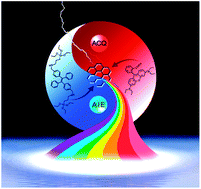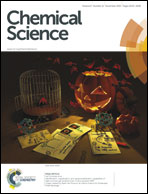Coupling of chromophores with exactly opposite luminescence behaviours in mesostructured organosilicas for high-efficiency multicolour emission†
Abstract
Aggregation-induced emission (AIE) and aggregation-caused quenching (ACQ) materials are important for various fluorescence-based applications but cannot easily collaborate because of their opposite luminescence behaviours. Here, we demonstrate a strategy to integrate AIE and ACQ chromophores in periodic mesoporous organosilicas (PMOs) for high-efficiency multicolour emission. Tetraphenylethene (TPE)-bridged AIE-PMOs are prepared as hosts to encapsulate ACQ dyes (e.g. RhB), which enables fine-tuning of ACQ@AIE-PMO emissions over the entire visible spectrum in the solid and film states. Significantly, high-quality white light is achieved with CIE coordinates of (0.32, 0.33) and a quantum yield of up to 49.6%. Because of their high stability and solution processability, the ACQ@AIE-PMOs can be applied in solid-state lighting and bioimaging. This design concept opens up new perspectives for developing high-performance luminescent materials by the combination of a wide variety of AIE and ACQ chromophores.


 Please wait while we load your content...
Please wait while we load your content...